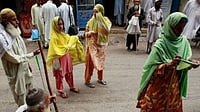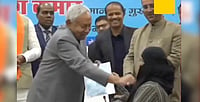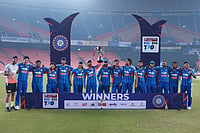Roland Perry's Bradman's Best, is arguably one of the best cases of a cricketenthusiast's fantasy. Enroute to becoming the best advertisement of this age -- old fancy,now buoyed by the fantasy game super selector, it has led a series of past greats andordinary followers of the game to follow suit with 'Best's' of their own.
Empirically rich in research, the book is a valuable contribution to the existingarchive of cricket literature, a contribution that, however, loses its significancesomewhat in the absence of a bibliography and detailed endnotes.
In demonstrating how the aura of the Bradman legend lives on, Perry also brings tolight, though in an obscure manner, some of the unworthy traits of the legend's character.Bradman's bitter rivalries with Fingleton and O'Reilly, his indifference towards racism,are elements often ignored in analyses of Bradman, facts buried under the weight andvolume of his unparalleled achievements.
By virtue of being titled, Bradman's Best, this book's marketable potential isdoubtless, enhanced by the author's noble proclamation of donating part of the saleproceeds of the book to the Bradman Museum. In describing the careers of each of Bradman'schoices, Barry Richards, Arthur Morris, 'The Don' himself, Sachin Tendulkar, Sir GarySobers, Don Tallon, Ray Lindwall, Dennis Lillee, Alec Bedser, Bill O'Reilly and ClarrieGrimett with Wally Hammond as twelfth man in detail, Perry, even if inadvertently, bringsbefore us a brief history of the game spanning the past seventy five years.
In doing so, he highlights the growing concerns of many of these players, oftenbattling with poverty, with the commercial potential of the sport, a concern that wenthand in hand with cricket's evolution from a pastime to a global spectacle under KerryPacker.
The book, part of a huge controversy, in the wake of it being published after Bradman'sdeath, has led critics to doubt its credibility and label the effort as being one steepedin a selfish commercial agenda.
Perry in stating that he had withheld the publication to prevent Bradman from beingtroubled by a renewed barrage of fan mail adds steam to this conjecture. This seems adefensive explanation, an act of justification unnecessary from an author. One suspectsthat Perry had anticipated the criticism even before the book was published.
In his essay on Bradman's choices and the reasons behind them, Perry is at his best.The detailed analysis behind each selection -- Morris and Richards preferred as openers toGavaskar for their aggression, and to necessitate a right and left hand openingcombination, is clearly reflective of Bradman's thinking cricket mind even at a ripe oldage.
This comes out best in his choice of Hammond as the twelfth man. Many would havepreferred a Colin Bland or a Jonty Rhodes for the position. But Bradman, aware of thehazards of the modern game and conscious that fitness problems are integral to it, optsfor Hammond, an able all rounder in all respects.
As Bradman's competitor, Hammond's batting prowess is well known. But his bowling andfielding skills, which had also influenced Bradman's choice, have largely remained ignoredin existing annals of cricket literature, facts well articulated by Perry.
In looking at Barry Richards, Perry provides the reader with some extremely interestingfacts about his rise from obscurity to stardom. 'At the end of his third year in countycricket in 1966, Richards didn't have enough money to watch a test between England and theWest Indies. At age 21, he cleaned out the West Indies dressing rooms and did jobs for theplayers, (he cleaned their pads) including Wes Hall, Rohan Kanhai, Garry Sobers and LanceGibbs, so he could see the game.'
Of great value are the detailed descriptions of the Australia versus South Africa Testseries of 1969-70, the one where the Aussies were trounced 4-0, their worst performanceever. These accounts throw light on the pool of Springbok talent lost to internationalcricket due to apartheid.
These men, Perry shows, had opposed the apartheid policy of the government, a factcomparable to India's cricket history where critiques of caste (now equated with race),were first articulated on the sporting field.
Also fascinating are the descriptions of rivalries between the Don and his twolegendary contemporaries, Grimett and O'Reilly. The tales of the legendary comebacks ofRay Lindwall and Dennis Lillee are something modern day speedsters like Shoaib Akhtar orJavagal Srinath may take heart from.
Trivia like Grimett's use of a Fox Terrier to fetch his balls during practice willenthrall many a quiz buff. All of the essays, however, though interesting to start withsoon degenerate into statistical rambling. Perry forgets that readers can access thesefigures and statistics from the Wisden almanacs and another monograph dedicated to thesame is totally unnecessary.
Perry's descriptions of the careers of Bradman and Tendulkar appear mundane and boring,more so in the absence of anything not already written on these greats. However factualerrors like confusing the name of Sachin's school 'Saradashram Vidyamandir' with'Saradashram English', and Dravid's omission from the list of Test players with averagesover fifty from a minimum of thirty test innings, could have been avoided.
Such omission brings back to focus the chief criticism labelled against Perry -- hiscommercial agenda. Was Dravid left out because he is less glamorous than his othercounterparts?



















_.jpg?w=200&auto=format%2Ccompress&fit=max)






